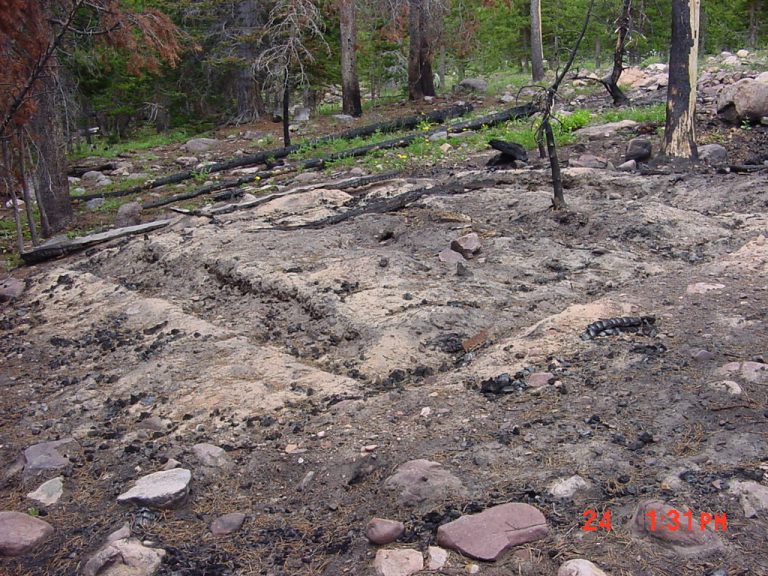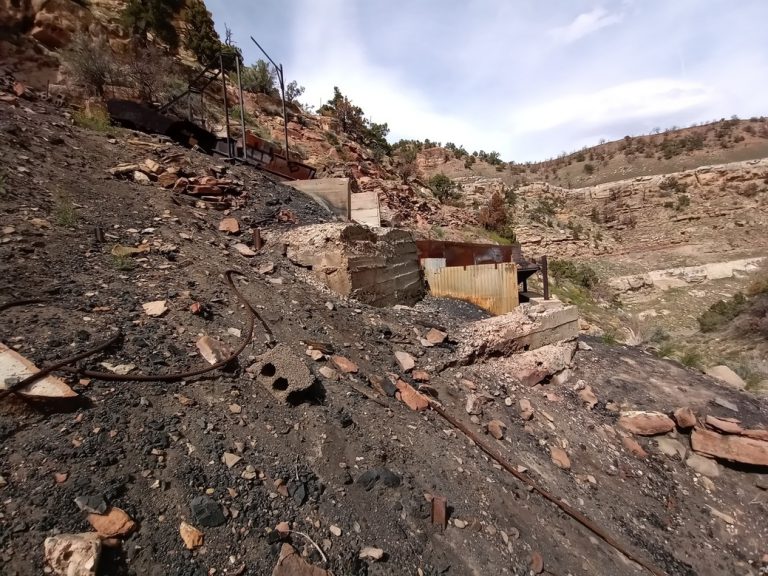As we enter yet another fire season, we all know the destruction that fires can have on air quality, watersheds, and even personal property and sadly human life and safety. As if all that wasn’t enough, wildfire can also destroy our state’s irreplaceable cultural heritage whether on public or private lands. We here at the State Historic Preservation Office wanted to add our unique voice to the chorus calling for the public’s help in preventing wildfires throughout Utah!
What Happens to Archaeological Sites When A Wildfire Burns Through?

Archaeological sites can’t run away as the flames approach, but what happens to sites that burn?
Cultural resources made of wood are obviously the most threatened by wildfires. This includes log cabins, wickiups, sweat lodges, bridges, railroad trestles, corrals, and a host of other types of resources. For example, in the early 2000s, a large wildfire on the North Slope of the Uintas (east of Mirror Lake Highway) started from a campfire getting out of control. With dead trees and high winds, the fire burned 14,000 acres of timber, but also destroyed at least 20-40 known sites related to the building of the transcontinental railroad. This part of the Uintas was logged in the 1860s through 1930s to supply railroad crossties (the wood that iron rail for trains is laid on) for the Union Pacific and Oregon Short Line railroads. Small log cabins for workers, barns for horses, and even remains of splash dams and flumes all burned, forever removing them from the landscape. The full impact of this human-caused and 100% preventable fire on cultural resources won’t be known because the area hadn’t been fully surveyed before or after the area.
If you want to learn more about the unique logging industry of the North Slope of the Uinta Mountains, an article was published in the Utah Historical Quarterly in 2016 and is free for viewing by visiting this link.

The damage isn’t limited to wood, though. Even rocks can break under the heat! Rocks are naturally porous and as they heat up, so does gas within their nooks and crannies. And since warming gasses expand, the rocks that contain them can explode! Arrowheads, grinding stones, even rock imagery and inscriptions are all possible casualties when the heat is on. For instance, archaeologists have found that modern intense forest fires actually can throw off important tools for dating sites with obsidian, by ‘resetting’ the clock on when those obsidian tools were left on the ground surface.
The ground itself becomes less stable after a wildfire because the plants, fungi, and microbial communities that help keep the soil intact often suffer. In the weeks and months after a wildfire, archaeological sites are left exposed to high winds and water runoff that can scramble artifacts and decimate the stratigraphy archaeologists rely on to date sites.
Read more about the effect of fire on obsidian here.
How Do Archaeologists Help?
Because of the importance of these resources, firefighting efforts on public lands include the insight and participation of archaeologists. Using an extensive database of archaeological sites, archaeologists look through files to identify sensitive cultural resources that should be avoided by ground disturbing activities like fire breaks or back burning. In some cases they can identify those sites that warrant an investment in protection through fire breaks, back burning, or even wrapping buildings in protective materials and placing sprinklers. In 2022, the State Historic Preservation Office completed a first-ever data sharing agreement with the Utah Division of Forestry, Fire and State Lands so that incident commanders are notified of any known cultural resources near initial attack activities. This will be a big step towards protecting even more historic and archaeological sites!
Unfortunately, Utah has lost many of its precious cultural resources from destructive wildfires caused by the public leaving unattended campfires, accidentally dragging chains, or even through direct arson. These lost resources can no longer share their unique story or give voices to the past.
Haven’t These Burned Before? Why Should We Be Concerned Now?
While many of these sites may have been left on the landscape for thousands of years, and even if they have been burned before, each time creates more problems through more cracks in rock imagery panels/boulders, eroding hillsides landslides, or even exposing these resources to increased vandalism and looting by removing the vegetation that was helping to hide them. While we can’t stop every fire, the preventable ones are human-caused, and those same humans usually are out on the landscapes enjoying these beautiful and history-rich places themselves. When an agency like the United States Forest Service or Bureau of Land Management plan a prescribed fire, they carefully consider the location of cultural resources in their planning to avoid impacts. Uncontrolled or unplanned fires do not have that same luxury.
Fire and Fire Prevention Can Help!
Returning to our example of the North Slope of the Uintas and the wooden history, the pro-active management of forests are helping to protect these cultural resources too. With the massive pine beetle epidemic that killed thousands of trees in the early 2000s in the area, the United States Forest Service completed years of planning to conduct prescribed burns and tree thinning to diminish fuel loads. With archaeologists surveying these proposed areas of disturbance, sensitive cultural resources were identified, and the projects planned to avoid them, but also provide a buffer against wildfire spread if it did occur by creating mosaics (or mixed areas of trees and thinned forests to limit the uncontrolled spread of fire). Dozens of logging history sites now are better protected by targeted forest management, though obviously there are many other benefits to these actions for other natural resources.
If you are a nerd and want to learn more about the impact of fire on cultural resources, please check out this publication by the United States Forest Service online and for free.
Help us not burn down history! To learn more about Utah’s Fire Sense Program, please visit: https://utahfiresense.org/
Special thanks to Utah’s Department of Natural Resources for their help with this blog Be sure to check out their Division of Forestry, Fire, and State Lands for up-to-date information on Utah’s fire season.